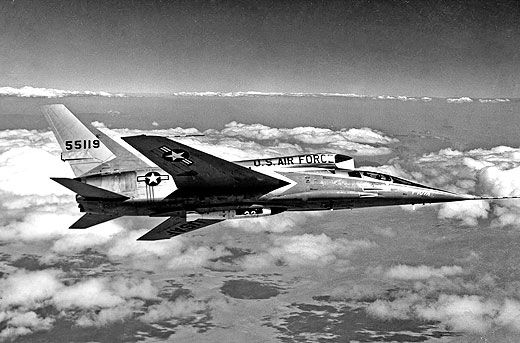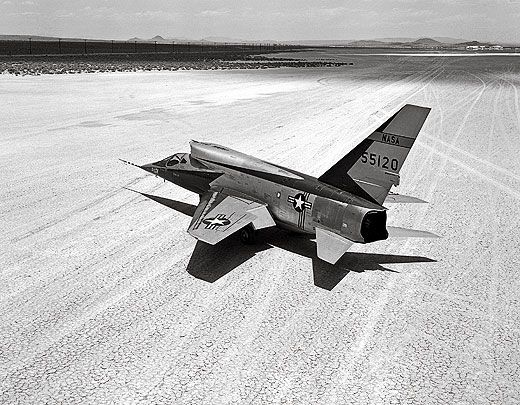Century Series Wannabe
North American F-107A
/https://tf-cmsv2-smithsonianmag-media.s3.amazonaws.com/filer/Century_Series_FLASH.jpg)
Depending on who’s talking, the North American F-107A was either the best fighter the Air Force didn’t have the sense to buy, or a politically flawed loser from the outset.
The F-107A will be remembered forever, if it is remembered at all, for being configured as no jet had been before or since: the sharp-edged maw of its air intake, feeding a prototype Pratt & Whitney YJ-75 engine, was just above and behind the cockpit, giving the otherwise sleek fighter the look of a fourth grader with an oversize backpack. In an era of dart-like Mirages and Delta Daggers, the F-107A was a single-engine-jet Winnebago.
The F-107As were built during the mid-1950s paroxysm of fighter/interceptor/fighter-bomber development that resulted in what came to be called the Century Series—all with -100 designations—which, except for the initial un-Area Ruled Convair F-102s, were the first reliably supersonic Air Force jets.
In the 1950s, every service but the Boy Scouts seemed to want nuclear-strike capability. And not only were the Air Force, Navy, and Army all competing to deliver The Bomb, within the Air Force, both Strategic and Tactical Air Commands wanted nuclear bombers, whether they were strategic goliaths or small tactical fighter-bombers. So rather than a bomb bay, the -107 had a kind of belly pouch that could half-cradle a hydrogen bomb to drop at Mach 2 from altitude or deliver from an under-the-radar approach.
That’s why the intake was piggyback. A conventional nose inlet would have required an internal air duct that would interfere with the centerline weapons station. Wing-root intakes that bracketed the bomb might have worked, but North American thought the dorsal tunnel straight back to the engine was a neater solution. (Some have claimed that wind tunnel tests showed airflow around a nose intake would interfere with bomb release, but no such testing was ever done on an F-107A.)
The -107A’s inlet ducting had panels that automatically choked off or opened the inlet to allow the proper amount of air to the engine at everything from double-supersonic to runway-approach speeds. The fighter-bomber lacked conventional flight control surfaces: Roll was controlled by spoilers rather than ailerons, an all-moving vertical fin instead of a
separate stabilizer and rudder worked yaw, and the horizontal stabilizer for pitch control was also an all-moving unit.
In his 2002 book, North American F-107A, William J. Simone recounts one of the hairiest F-107A flights, which was made outside the testing program. Air Force Major Clyde Good delivered the number-two airplane to the Air Force museum in Dayton, Ohio, in November 1957. Good’s -107A, by then almost ready for the scrap yard, had no navigation radios, so he planned a day trip to follow an F-100 Super Sabre from Edwards Air Force Base in California to Wright-Patterson Air Force Base, where the museum is located.
Problems at a refueling stop en route resulted in Good becoming separated from his lead, and after following highways as far as St. Louis, he ended up in the dark, atop an undercast. He had already discovered that the airplane had no cockpit or instrument lights, since it was never intended to fly at night. Nor had Good intended to fly at night, so he hadn’t bothered to pack a flashlight—just a Zippo lighter that he occasionally flicked to check the instruments. He guessed at a heading from St. Louis toward Dayton, and eventually Wright-Pat radar picked him up and vectored him down through the clouds and onto final.
Gear down, landing lights on…oh wait, no landing lights either. Good set down with one hand on the stick and the other on his Zippo so he could monitor the approach speed.
After three F-107As were built, the development contract was canceled in favor of the Republic F-105 Thunderchief, which went on to do yeoman service in Vietnam (see "Thuds, the Ridge, and 100 Missions North," Feb./Mar. 2009). But at the time the Office of the Secretary of the Air Force made that decision, the F-105 had flown for barely nine hours and had already exhibited, in the words of Air Force test pilot Mel Apt, "more deficiencies than are normally encountered in other aircraft at a similar stage of development." The F-105 had an internal bomb bay, however, which Tactical Air Command loved—it wasn’t sort of a bomber, it was a bomber—and the Air Force wanted to find work for slumping Republic, while North American already had the F-100 and follow-on F-86 programs to keep it busy.
With one F-107A safely ensconced in the Air Force museum, the other two served in the late 1950s with the National Advisory Committee for Aeronautics (later NASA). Today only one remains, at the Pima Air and Space Museum, in Tucson, Arizona.
Stephan Wilkinson is an aviation and military history writer, homebuilt-airplane assembler, and Porsche restorer. When he has nothing else to do, he builds model aircraft.

